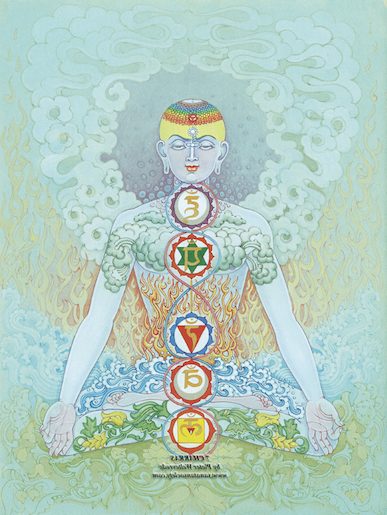
“Everything you see has its roots in the unseen world. The forms may change, yet the essence remains the same.” ~ Rumi
~
The chakras are part of our subtle energy body system.
They exist in the pranamaya kosha or the life force layer of our being. These “wheels” or vortices of energy influence our mental, emotional, physical, and spiritual realities. Knowledge about this system derives from the Vedas—ancient Indian texts—however, our understanding today has largely been shaped by Western perspectives.
Wisdom in this area can help us take responsibility for our healing. We can harness this energy to deepen our self-knowledge and live to our fullest self-expression as a human being.
There are many chakras in the subtle energy body. The Hindu tradition identifies seven primary centers through which our prana, or life force, flows. These energy points are said to move in a rotating motion down the spinal column, each chakra having a particular color, sound, and density. They can be opened and closed, strong and balanced, or weak and unbalanced.
Muladhara:
This first chakra, also known as muladhara or “root support,” rotates at the base of the spine, at the tailbone, and also surrounds the three vertebrae following it. It is the seat through which primordial power or shakti flows.
Did you know that the muladhara chakra hosts another seven minor chakras which descend down to the feet? It is the chakra that carries all the others, and this is why we must work to balance and ground this energy before trying to attain enlightenment from the top such as through the brow and crown chakras.
Muladhara holds the densest energy field and represents not only our physical body, but everything in our secondary reality—our concrete environment.
A strong root chakra reflects a person who feels at home within the self and world with an ability to manifest desired experiences with confidence and ease. Because this center expresses our primal nature, a balanced chakra here means that our instincts are sharp; fear can be the guide, not the ruler of our actions. The manifest world gives us that which we need because of our innate self-trust, including healthy relationships and stable finances. Our physical appearance and environment are well looked after.
A weak first chakra reflects a person who lives in the flight, freeze, and fight mode—chronic stress and anxiety may be an issue. We feel a level of disconnection with self (mentally, physically, and emotionally) and others. We worry about money, home, and there may be a lack of safety and security with family and relationships—we question our sense of belonging overall.
Our physical environment may be cluttered, and we find it hard to structure our time and get organised. We feel that support is lacking, and asking others for support is also a difficult task. Any physical body issues or illnesses—including feeling chronically fatigued—reflect imbalances here.
How can we begin to balance the root chakra?
The ultimate way to heal muladhara is to meet all of our basic needs! Let’s think of our inner child—what are her needs? What does she need to feel safe and secure, healthy and happy?
Do we do those things that build self-loyalty, self-support, and trust? Or do we go against our own nature and say yes when we mean no, for example.
To understand and root ourselves in reality, to accept the way things are right now, can be very powerful to ground our attention.
Practicing gratitude for little things in our day is another way to shift feelings of lack and scarcity, which come from weaknesses in this chakra.
Take these five practical steps now to transform the root chakra:
1. Declutter.
Pick the room you spend the most time in and start there. Purge, remove, dust, and clean every nook and cranny in your space. Remember that our physical environment reflects our inner state. Use the principals of feng shui to add magic and speed to this transformational activity.
While you’re at it, get rid of anything that does not reflect who you are now and where you’re going. Muladhara is associated with our physical identity as much as our space.
Add a spiritual cleansing technique when you’re done, such as smudging sage around your space, and watch miracles unfold with your reality!
2. Meditate.
Even just five minutes in the morning or before you sleep can be beneficial. Remember to lengthen your spine to encourage the alignment of your chakras. It is said that the root chakra is associated with the colour red, so visualize this hue as a ball of light radiating beneath your tailbone and expanding outward. Along with this, I love to imagine sitting beneath a tree and drawing in its stabilizing life essence—of course, to do this in real life is even better! And as I exhale, I visualize myself rooting into the earth deeper with every breath.
3. Move your body.
Embodiment is key for a healthy first chakra. Practice hatha yoga, martial arts, or dance—any physical activity that brings you a sense of joy and self-connection. You can do this at home, even! Hatha yoga is wonderful to connect mind, body, and breath. Make sure to focus your attention on the physical sensations as you stretch and hold a posture. Practice poses lower to the ground—skandasana, or side lunge, and malasana, the low squat, for example, are great postures to connect with earth’s energy. Try practicing the mula bandha, the yogic root lock to strengthen the physical area of the chakra.
4. Pay attention to your food choices.
I’ve noticed a correlation between food, money, and relationships—how well we nourish our inner life, including what we feed our body, affects what is manifested in our outer reality. As within, so without.
Try this thought experiment: if you feel financially unstable, check to see if you’re eating junk food or foods that trigger allergies within your body. Do the foods you eat deplete your vitality? Are you always eating for pleasure and not for health?
In turn, do your relationships reflect a level of toxicity? Start befriending your physical body, eat for health and vitality, and see what transforms in other areas of your world.
Eat more protein and especially grounding foods—root vegetables such as sweet potato, beetroot, carrots, and turmeric, for instance.
5. Grab your journal and answer these questions:
>> What is my current reality, and how am I viewing it? (Think in respect to the areas of home, relationship, career, and health.)
>> What am I doing or can I do right now to meet my basic needs?
>> Who is supporting me, and how can I gather more support?
>> Write down five things you’re grateful for that provide you with a sense of inner stability, safety, and support.
Share your thoughts about your root chakra—which areas of your life reflect healthy and grounded or weak and misaligned energy?
~
Author: Payal Patel
Image: Wikimedia Commons
Editor: Catherine Monkman
Copy & Social Editor: Yoli Ramazzina

 Share on bsky
Share on bsky





Read 0 comments and reply